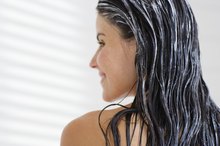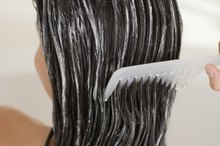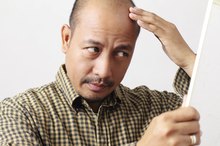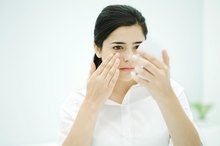What does fact checked mean?
At Healthfully, we strive to deliver objective content that is accurate and up-to-date. Our team periodically reviews articles in order to ensure content quality. The sources cited below consist of evidence from peer-reviewed journals, prominent medical organizations, academic associations, and government data.
The information contained on this site is for informational purposes only, and should not be used as a substitute for the advice of a professional health care provider. Please check with the appropriate physician regarding health questions and concerns. Although we strive to deliver accurate and up-to-date information, no guarantee to that effect is made.
Dry hair and scalp products take prominence in beauty advertising, but this doesn’t mean oily hair is less of a problem 2. Excess oil in the hair can stem from issues in the scalp or from beauty habits. Minor issues may be corrected at home with changes in your hair care routine.
Sebaceous Glands Control Shine
Every pore on your skin has a sebaceous gland, including your scalp. Better known as oil glands, these are responsible for maintaining proper hydration levels by producing sebum (oil). When it comes to your hair, sebum is responsible for giving your strands a healthy shine. However, some sebaceous glands produce excess oil, making your hair greasy. If you have oily skin, then you’re more likely to have oily hair 2. Daily shampoos are the best way to control excess grease from the overproduction of oil.
- Every pore on your skin has a sebaceous gland, including your scalp.
- However, some sebaceous glands produce excess oil, making your hair greasy.
How Hair Type Dictates Oiliness
How to Prevent Dandruff in Black Hair
Learn More
Your hair type is another factor in controlling excess grease and oil from the sebaceous glands of the scalp. Thick, curly hair may appear dry on the ends but greasy at the scalp. When the oil glands produce too much sebum, your curls may prevent even distribution. For this reason, you may shampoo less but end up with a greasy scalp and dull ends. Spray dry shampoo to your roots in between washes to control excess oil at the scalp without stripping it away from the rest of your hair.
- Your hair type is another factor in controlling excess grease and oil from the sebaceous glands of the scalp.
- Spray dry shampoo to your roots in between washes to control excess oil at the scalp without stripping it away from the rest of your hair.
Hormones Increase Oil Production
Increased hormones during puberty are often to blame for excess oil in the hair. Considering this fact, dealing with oily hair during adulthood may be confusing 2. However, other types of hormone fluctuations can cause oily hair as an adult 2. Birth control pills are a leading cause in women, as well as pregnancy. Hormonal issues in both men and women can lead to excess sebum production in the scalp.
- Increased hormones during puberty are often to blame for excess oil in the hair.
Oily Hair Routines
Dry vs. Oily Scalp
Learn More
Certain factors can cause oily hair, but your personal care routine may also be to blame 2. Excess scrubbing during shampooing can irritate the scalp, causing more oil, as well as too many washes. Your hair should never be washed more than once a day. If you have an oily scalp, don’t brush your hair too much, as this will distribute the grease throughout your strands 2. You may also consider making over your hair care cabinet with styling products that don’t contain lotions and creams.
When Beauty Routines Fail
If regular shampooing doesn’t control oily hair, it may be time to consider other causes 2. This is especially the case if excess oil is accompanied by dandruff flakes. Seborrheic dermatitis can cause oily hair because of high sebum production 2. This condition is characterized by yellow, oily patches on the scalp. The oil quickly makes its way from the scalp to your strands. Psoriasis, caused by excess skin cell turnover, may also cause oily hair if your sebaceous glands overproduce sebum 2. Unlike seborrheic dermatitis, psoriasis is red and silvery in appearance. Both conditions may appear as annoying dandruff at first, but is persistent despite shampooing. See your doctor if oily hair is accompanied by any of these signs 2.
Related Articles
References
- Nemours Foundation: Hygiene Basics
- MedlinePlus: Oily Hair
- Phillips TG, Slomiany WP, Allison R. Hair Loss: Common Causes and Treatment. Am Fam Physician. 2017;96(6):371-378.
- Watras MM, Patel JP, Arya R. Traditional anticoagulants and hair loss: a role for direct oral anticoagulants? A review of the literature. Drugs Real World Outcomes. 2016;3(1):1-6. doi:10.1007/s40801-015-0056-z
- Urysiak-czubatka I, Kmieć ML, Broniarczyk-dyła G. Assessment of the usefulness of dihydrotestosterone in the diagnostics of patients with androgenetic alopecia. Postepy Dermatol Alergol. 2014;31(4):207-15. doi:10.5114/pdia.2014.40925
- Vincent M, Yogiraj K. A descriptive study of alopecia patterns and their relation to thyroid dysfunction. Int J Trichology. 2013;5(1):57-60. doi:10.4103/0974-7753.114701
- Peters EMJ, Müller Y, Snaga W, et al. Hair and stress: A pilot study of hair and cytokine balance alteration in healthy young women under major exam stress. PLoS ONE. 2017;12(4):e0175904. doi:10.1371/journal.pone.0175904
- Pratt CH, King LE, Messenger AG, Christiano AM, Sundberg JP. Alopecia areata. Nat Rev Dis Primers. 2017;3:17011. doi:10.1038/nrdp.2017.11
- American Academy of Dermatology. Alopecia Areata: Overview.
Writer Bio
Kristeen Cherney began writing healthy lifestyle and education articles in 2008. Since then, her work has appeared in various online publications, including Healthline.com, Ideallhealth.com and FindCollegeInfo.com. Cherney holds a Bachelor of Arts in communication from Florida Gulf Coast University and is currently pursuing a Master of Arts in English.









